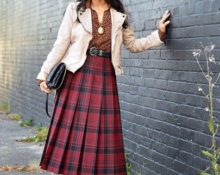A skirt is one of the most popular items in a woman's wardrobe. It is very easy to get confused in the multitude of their names. You will learn about the name of a pleated skirt and what its features are in this article.

History and significance
This skirt is called pleated, or simply pleated. First you need to understand the meaning of this word. It is borrowed from French, in which it is a participle. The verb "plisser" means to wrinkle, wrinkle, or fold. Hence the meaning of the participle “plissé” - “gathered in folds” (about an object/product) or “wrinkled” (about a face).

In addition to pleated, there are “corrugated” models; the word is also borrowed from French. The verb "gaufrer" means "to press out/print a relief design." Corrugated products have smaller folds that widen towards the bottom. The fabrics selected are light, flowing, and translucent.

The ancestor of the modern pleated skirt is the kilt. The product owes its appearance to the culture of Scotland.This is an element of traditional highlander clothing: it is a piece of pleated fabric wrapped around the hips and secured with special devices. Most often it is complemented by a small handbag, which is placed in front. Made from tartan fabric.
In ancient times, it was used by warriors, as it did not hinder movements and retained heat. In the modern world, the kilt is used as an element of official (traditional holidays, parades) or wedding costume. Very few Scots wear it as casual wear. If only because for modern people who do not understand the culture of the people, a man in a skirt looks quite comical.

Manufacturing method: the fabric is processed with a special press, parallel folds are formed on the fabric, which remain on the product forever.
The method was patented by the Spanish-Italian fashion designer Mariano Fortuny, who created the pleating by hand. Initially they were intended for use at home, but later they came into wider use and became fashionable.
Peculiarities

- The product is universal. There is a huge variety of styles, freedom in the use of fabrics, colors, patterns. The model can be either strict, suitable for office style, or lighter, free or even festive. The main thing is to decide on the required style and choose a model.
- This manufacturing method can correct figure flaws. Pleated models are suitable for girls who want to hide volume in the hips: in this case, it is necessary to choose products with large pleats. The corrugated version, on the contrary, can create the necessary volume on a thin figure.Curvy models will make an angular silhouette more proportional and feminine: they emphasize the waist and make the hip line smoother.
- Styles. There is a huge variety of models suitable for certain cases:
- lush;
- straight;
- pencil;
- packs;
- length: maxi, midi, mini;
- folds: bow, circular and counter (on midi and mini models);
- The most popular print is tartan; it is often used to create school uniforms. There are also single-color options.



 0
0





